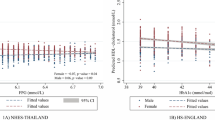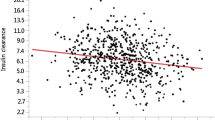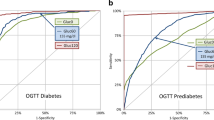Abstract
OBJECTIVES: To investigate: (i) the incidence of impaired fasting glycaemia (IFG) developed over 5 y in a population-based sample of Australian-born women; (ii) prospectively the factors which are associated with the development of IFG; (iii) the association of the menopausal transition with the onset of IFG and an increase in serum insulin concentrations.
DESIGN AND METHODS: A total of 265 women (110 pre-, 138 peri-, 17 postmenopausal) participants in the longitudinal phase of the Melbourne Women's Midlife Health Project, aged 46–57 and with normal fasting plasma glucose concentrations at the time of the initial measure, were interviewed, had physical measurements and blood taken annually over a 5 y follow-up period.
RESULTS: During the study period 43 women (16%) recorded a fasting glucose concentration of ≥6.1 mmol/l (IFG). Women who recorded IFG prospectively had, at the time of the initial measure when fasting glucose concentrations were normal: higher body mass index (BMI), trunk skinfold thicknesses, waist and hip circumferences (P<0.005), lower SHBG, higher free androgen index and serum insulin concentrations (P<0.05), higher systolic blood pressure, serum triglyceride and lower HDL-cholesterol concentrations (P<0.05) than women whose fasting glucose concentrations remained normal. The onset of IFG was not triggered by the menopausal transition or hormone use. Changes in insulin concentration were associated with changes in BMI (P<0.05).
CONCLUSION: Women who developed IFG during the menopausal transition exhibited significantly higher levels of body fatness and dyslipidemia, premenopausally, compared with the women who did not develop IFG. The menopausal transition did not have an effect on the development of IFG, but weight gain during this period was associated with an increase in insulin concentration.
This is a preview of subscription content, access via your institution
Access options
Subscribe to this journal
Receive 12 print issues and online access
$259.00 per year
only $21.58 per issue
Buy this article
- Purchase on Springer Link
- Instant access to full article PDF
Prices may be subject to local taxes which are calculated during checkout

Similar content being viewed by others
References
Manson JE, Colditz GA, Stampfer MJ, Willett WC, Krolewski AS, Rosner B, Arky RA, Speizer FE, Hennekens CH . A prospective study of maturity-onset diabetes mellitus and risk of coronary heart disease and stroke in women Arch Intern Med 1991 151: 1141–1147.
Matthews KA, Meilahn E, Kuller LH, Kelsey SF, Caggiula AW, Wing RR . Menopause and risk factors for coronary heart disease New Engl J Med 1989 321: 641–646.
Kissbah AH, Krakower GR . Regional adiposity and morbidity Physiol Rev 1994 74: 761–811.
Seidell JC, Bouchard C . Visceral fat in relation to health: is it a major culprit or simply an innocent bystander? Int J Obes Relat Metab Disord 1997 21: 626–631.
Poehlman ET, Toth MJ, Gardner AW . Changes in energy balance and body composition at menopause: a controlled longitudinal study Ann Intern Med 1995 123: 673–675.
Guthrie JR, Dennerstein L, Dudley EC . Weight gain and the menopause: a 5-year prospective study Climacteric 1999 2: 205–211.
Colman PG, Thomas DW, Zimmet PZ, Welborn TA, Garcia-Webb P, Moore MP . New classification and criteria for diagnosis of diabetes mellitus Med J Aust 1999 170: 375–378.
Dennerstein L, Smith AMA, Morse C, Burger HG, Green A, Hopper J, Ryan M . Menopausal symptoms in Australian women Med J Aust 1993 159: 232–236.
Burger HG, Dudley EC, Hopper JL, Shelley JM, Green A, Smith A, Dennerstein L, Morse C . The endocrinology of the menopausal transition: a cross-sectional study of a population-based sample J Clin Endocrinol Metab 1995 80: 3537–3545.
Dudley EC, Hopper JL, Taffe J, Guthrie JR, Burger HG, Dennerstein L . Using longitudinal data to define the perimenopause by menstrual cycle characteristics Climacteric 1998 1: 1–8.
SPSS for Windows . Statistical package for social sciences, Version 8.0 SPSS Inc.: Chicago, IL; 1996.
Tchernof A, Calles-Escandon J, Sites CK, Poehlman ET . Menopause, central body fatness, and insulin resistance: effects of hormone replacement therapy Coron Artery Dis 1988 9: 503–511.
Haffner SM, Valdez RA, Hazuda HP, Mitchell BD, Morales PA, Stern MP . Prospective analysis of the insulin resistance syndrome (Syndrome X) Diabetes 1992 41: 715–722.
Haffner SM, Stern MP, Hazuda HP, Mitchell BD, Patterson JK . Cardiovascular risk factors in confirmed prediabetic individuals: does the clock for coronary heart disease start ticking before the onset of clinical diabetes? JAMA 1990 263: 2893–2898.
Do KA, Green A, Guthrie JR, Dudley EC, Burger HG, Dennerstein L . A longitudinal study of risk factors for coronary heart disease across the menopausal transition Am J Epidemiol 2000 151: 584–593.
Larsson H, Ahren B, Lindgarde F, Berglund G . Fasting blood glucose in determining the prevalence of diabetes in a large, homogenous population of caucasian middle-aged women J Intern Med 1995 237: 537–541.
Stern MP, Morales PA, Valdez RA, Monterrosa A, Haffner SM, Mitchell BD, Hazuda HP . Predicting diabetes. Moving beyond impaired glucose tolerance Diabetes 1993 42: 706–714.
Bruschi F, Meschia M, Amicarelli F, Bologna E, Curtarelli M, Crosignani PG . Changes in sex hormone-binding globulin plasma concentrations induced by body weight and estrogen status in perimenopausal years Menopause 1997 4: 28–31.
Burger HG, Dudley EC, Cui J, Dennerstein L, Hopper JL . A prospective longitudinal study of serum testosterone, dyhdroepiandrosterone sulfate, and sex hormone-binding globulin levels through the menopause transition J Clin Endocrinol Metab 2000 85: 2832–2838.
Haffner SM, Valdez RA, Morales PA, Hazuda HP, Stern MP . Decreased sex hormone-binding globulin predicts non-insulin-dependent diabetes mellitus in women but not in men J Clin Endocrinol Metab 1993 77: 56–60.
Lindstedt G, Lundberg GA, Kitabchi AE, Wilmas JA . Low sex-hormone-binding globulin concentration as independent risk factor for the development of NIDDM: 12-year follow-up of population study of women in Gothenburg, Sweden Diabetes 1990 40: 123–128.
Taylor AE . Polycystic ovary syndrome Endo Metab Clin N Am 1998 27: 877–901.
Anderson B, Mattsson L, Hahn L, Marin P, Lapidus L, Holm G, Bengtsson B, Bjorntorp P . Estrogen replacement therapay decreases hyperandrogenicity and improves glucose homeostasis and plasma lipids in postmenopausal women with non insulin-dependent diabetes mellitus J Clin Endocrinol Metab 1997 82: 638–643.
James WP . The epidemiology of obesity CIBA Found Symp 1996 201: 1–11.
Barnett AH, Eff C, Leslie RDG, Pyke DA . Diabetes in identical twins: a study of 200 pairs Diabetologia 1981 20: 87–93.
Manson JE, Rimm EB, Stampfer MJ, Colditz GA, Willett WC, Krolwski AS, Rosner B, Hennekens CH, Speizer FE . Physical activity and incidence of non-insulin-dependent diabetes mellitus in women Lancet 1991 338: 774–778.
Acknowledgements
This study was supported by grants from the Victorian Health Promotion Foundation, the Public Health Research and Development Committee of the Australian National Health and Medical Research Council, and the Australasian Menopause Society. We thank Mr Nick Balazs and the staff of the Department of Biochemistry at the Monash Medical Centre for the glucose, hormone and lipid assays and Dr Duo Li for performing the insulin assays.
Author information
Authors and Affiliations
Corresponding author
Rights and permissions
About this article
Cite this article
Guthrie, J., Ball, M., Dudley, E. et al. Impaired fasting glycaemia in middle-aged women: a prospective study. Int J Obes 25, 646–651 (2001). https://doi.org/10.1038/sj.ijo.0801569
Received:
Revised:
Accepted:
Published:
Issue Date:
DOI: https://doi.org/10.1038/sj.ijo.0801569
Keywords
This article is cited by
-
Cardiovascular health in the menopause transition: a longitudinal study of up to 3892 women with up to four repeated measures of risk factors
BMC Medicine (2022)
-
Cohort profile: Women’s Healthy Ageing Project (WHAP) - a longitudinal prospective study of Australian women since 1990
Women's Midlife Health (2016)



